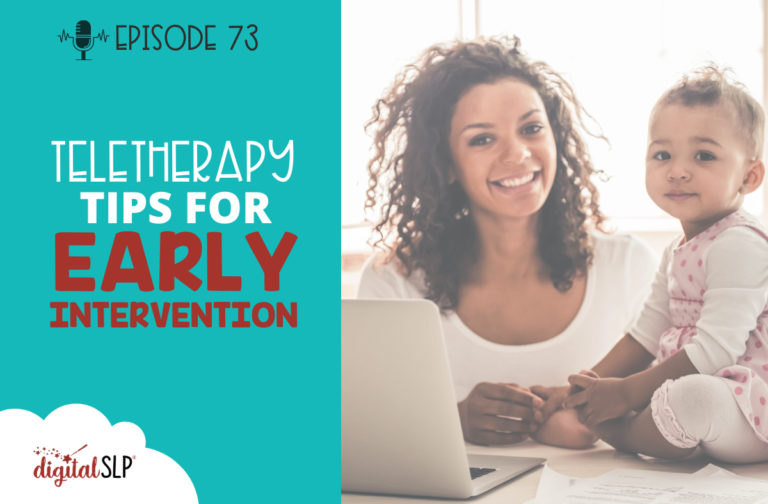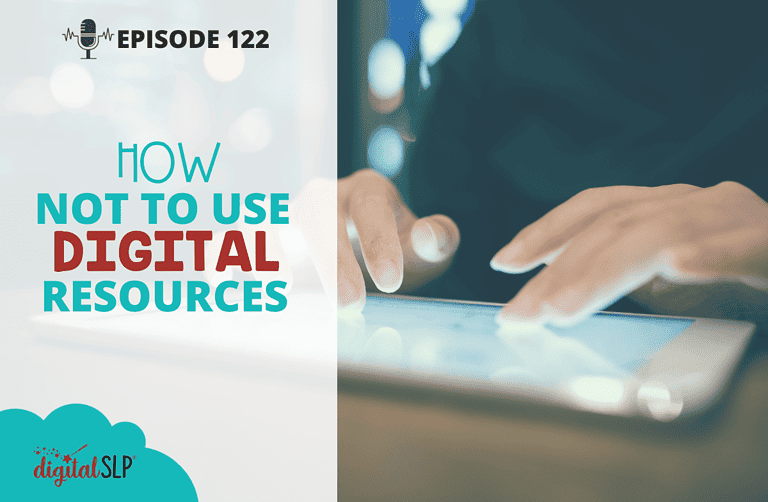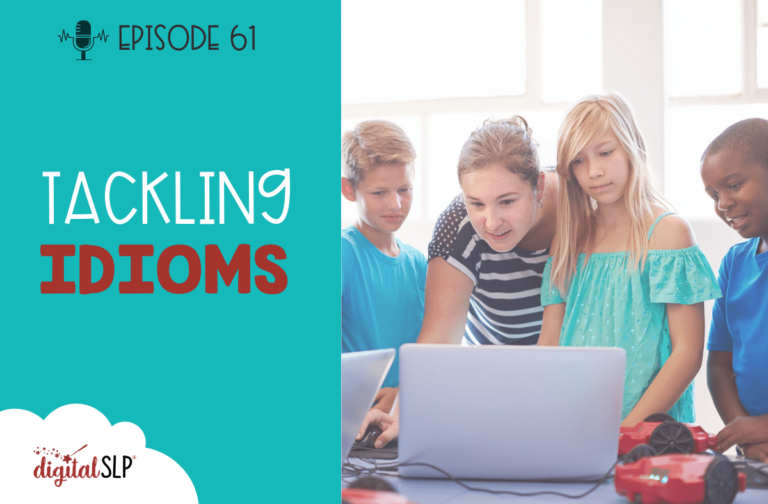In this episode, I cover loads of tips for conducting your early intervention teletherapy sessions with confidence. Tune in to learn how to increase engagement, parent involvement, and keep your sessions running seamlessly!
Today we are going to be talking about teletherapy tips for early intervention when providing teletherapy for young children as it may be a new concept for many of us. Some of us might be wondering:
- How do we prepare for the session?
- What are the ways to keep the child’s attention during the teletherapy?
- What happens if the child does not want to participate?
Today’s podcast discusses how we can prepare for your child’s early intervention teletherapy sessions. I am going to be providing some tips and tricks to both plan and execute fun and engaging teletherapy sessions for young children in early intervention.
Some of the must-dos when preparing for the sessions:
- Review the session ahead of time with the parents so they know what to expect in the session and can prepare for it
- Caregiver must be present to ensure a successful session
- Use a tablet or computer (avoid using a phone)
- Good quality Internet connection/ Wi-Fi (avoid mobile hot spot)
Fun and interactive activities:
- Music – instruments, child’s favorite songs, improvise with what’s available around the house
- Cars – keeping the children’s attention
- Baby dolls – peek-a-boo games, pretend play
- Use resources to share the screen for fun and engaging activities
Teletherapy Tips for Early Intervention – Links and Resources:
Full Transcript of Podcast: Teletherapy Tips for Early Intervention
Episode 73: Teletherapy Tips for Early Intervention
You're listening to the Speech Space Podcast, a podcast full of tips and resources for SLPs. I'm your host, Jessica Cassity, and this is Episode 73.
Hey there! Today, we are going to be talking about providing teletherapy to children in early intervention. Before we get started, I did want to mention that this podcast is brought to you by The Digital SLP membership site, which is a site that features time-saving, interactive digital resources that are all teletherapy platform-friendly. You can learn more or sign up by going to thedigitalslp.com/digitalslp.
All right, so let's go ahead and dive right in. Providing teletherapy to children in early intervention may be a new concept to many of you and you might be thinking, how do I prepare for these sessions? Or how do I ever keep the child's attention over a computer? Maybe you've even thought, what happens if a child does not want to participate? So today I'm here to give you some tips and tricks to both plan and execute fun and engaging teletherapy sessions for children in early intervention.
So let's go ahead and start with prep work. Here are some must-do's when planning for teletherapy sessions for young children. So you want to make sure that you review sessions with parents ahead of time. So they know what to expect in the sessions and how they can prepare on their end. By providing parents an idea of what the session is going to look like, they're also able to feel more confident and prepared when they're going into the session. This also allows parents to be able to set up their space to allow for reduced distractions, and then to provide the child with the proper tools they're going to need during that session. Sending the parents materials beforehand or asking them to grab some items around the house that they might already have, it also saves time during the session as well. Another thing that you want to keep in mind before your sessions is you want to express to the parents before even initiating therapy that a caregiver must be present during all teletherapy sessions. Children need hands-on support, not only to navigate the technology, but also to be able to understand language and express their thoughts and ideas appropriately during the session. So having a caregiver there is crucial in completing a successful teletherapy session. You as a therapist are likely only working with the child once a week, whereas caregivers are going to be there with their child 24/7. So if a caregiver isn't fully present during the sessions, they're going to have a very difficult time taking all the strategies and techniques taught throughout the sessions in using them each day with their child. One last thing you want to keep in mind in terms of preparing for your session is to be sure to either use a tablet or computer, if possible, and not a phone. I know when the pandemic first started, we kind of we're all doing, you know, whatever we needed to do, but under more ideal circumstances, we want to make sure we're using a tablet or computer. And you also want to encourage the caregivers do the same thing. This allows the child to be able to see the therapist more clearly and engage. Also, you want to ask the caregivers if they're able to place their device on a stand or something stable so it's not shaky. And then the last thing you want is the caregiver walking around the room, holding the tablet and computer, and following the child. So the only thing the caregiver will be able to focus on throughout the session is being sure the child is in the camera and not on the strategies that you as a therapist are providing. So you want to make sure it's stable, that they are in that camera, and they're sitting somewhere. Or they're not necessarily going to be moving all around because you want to make sure that they're able to see you and engage. On the other reason that we want to make sure that we're using tablets and computers. We want it... well, I guess I should say, what we want to make sure we're doing also is using a WiFi connection. We don't want to be using a cell phone on a hotspot or, you know, using our cell phone service provider. We want to make sure that we have a good quality connection. And we also want our parents to be doing the same.
Now let's go ahead and talk about some fun activities that you can use within your sessions to keep your little ones interactive and engaged during the entire session. So, first thing I want to talk about is music. So try bringing instruments or even finding the child's favorite songs to play in your sessions. You know, music always brings more fun to therapy sessions. You want to see if the caregivers have instruments of their own. So you can play the instruments together at the same time. You can work on exposing the child to various action words like shake, bang, clap, tap, dance, stomp, and so many more action words like that. If they don't have instruments, that's okay too. You know, you can have them get a spoon and a pot, and you can have them get a lot of things around the house. You can have them make a little shaker. You know, you can do one of those toilet paper rolls where you have wax paper on either end with a rubber band and put little beans or, you know, some sort of dried type legume inside. It can make a little shaker rattle. You can fill an old Easter egg with some things like that to make that shaking sound. So even if they don't have instruments, that's okay. You can guide them through some little hacks to make their own to have at home. I mean, you can also find favorite songs on YouTube, and you can pause the song to see if the child will attempt to fill in the blank of the next word in the song. So if you begin playing say, "Old MacDonald had a farm," you can pause a song right before the animal sound to see if the child can make the animal sound. So, you know, kids just love music and they respond so well to it. So make your sessions fun with song. Don't be afraid to make up songs during sessions as well to describe what you're doing. So you can always do a little bit of improv too.
All right, let's talk about cars next. There are so many fun things that you can do with cars during sessions to keep the student or the child's interest and attention. So if you have a ramp, bring it into the session. Children love watching balls or cars or anything, slide down a big ramp during sessions. There are many different concepts that you can target while using cars with a ramp as well. One of them is stop and go. So you have the car at the top of the ramp and wait to let the car go down until the child non-verbally or verbally expresses their want for the car to go. You can also make the car stop while halfway down the track, providing another opportunity for them to request the car to go. If you are not using a ramp, you can still work on the concept of stop and go with cars on the ground. You can use cars to knock down towers or bowling pins or any other materials that you have lying around. You can wait for the child to express the word go and then have the car knock down whatever you have there that's stacked up. Another thing you can do with cars is up and down. So if you are using a car ramp, you can work on the car going up, up, up the ramp or down, down, down the ramp. And you can encourage the child to request up by lifting their arms up into the air. And this is a great concept to work on since children likely request up many times during the day, when they're asking their caregivers to hold them. When working on up and down concept with cars, this is a great coachable moment with parents to explain that they can use the same concept when requesting to get up out of the crib or up from the high chair. You can use these opportunities to teach parents how to generalize these concepts from these specific toys to more functional and everyday activities. Another one that you can do with the cars is fast and slow. Now this concept is a fun one to demonstrate on camera. So you're going to choose cars that go super fast down the ramp or very slow down the ramp. And you can do the same thing without a ramp, making cars go fast or slow across the floor. So don't worry if you don't have a ramp, you can still improvise. And what you're going to do here is you're going to have the child also take a car and practice making their car go fast or slow. So again, this is a great opportunity where you're showing parents how to incorporate this concept of fast and slow into everyday functional activities. You want to provide fun ideas of creating movement activities, where the child runs fast and then moves slow across the room. You can even try playing a cleanup game where the child puts toys in the bucket super fast and then puts them in the buckets super slow. So those are a few ideas where you can work on fast and slow.
All right, let's move on to using baby dolls in your EI teletherapy session. So one of the first things you can try with using baby dolls is peek-a-boo games. So you can bring a baby doll into the session and have the child also bring their own doll. You're going to grab a blanket or a scarf and you're going to hide the baby. Now you can work on basic imitation skills like imitating boo, or off, or more! And you can also work on imitation of actions. If the child isn't quite ready to imitate sounds or words. Imitating the action of taking the blanket off the baby, or maybe holding the hands up when saying, where's baby? If the child doesn't have a baby doll, just have the caregiver grab a blanket and have the caregiver hide underneath. They can even take turns and the child can hide as well. And by doing that, you're also getting the caregiver actively involved in the session. If the child's working on language comprehension skills, you can work on identifying body parts with the baby doll, like finding the baby's nose, or eyes, or hands. You can also work on understanding of basic directions, such as give baby the car or let's make baby jump, or maybe baby is hungry, let's give her some food. So there's lots of opportunities there as well. Don't forget, pretend play skills. So you want to work on play skills through feeding baby or giving baby something to drink or making baby go to sleep. There are so many different language concepts that you can target in pretend play. And one of my favorites is feeding baby different foods, and then seeing if baby spits out the food. So you can work on vocabulary, naming different play food items, and then you can watch babies start to eat the food, and then see if baby says, blah, while spitting it out, or if the baby says, mm, or yummy, and continues to eat. You know, these are easier sounds for children to imitate and they really love to watch in suspension to see what the baby's going to do. So that's a really fun one.
Okay. So my last tip here is to use resources to share the screen. So don't be afraid to share your screen and incorporate fun and engaging games or activities on the computer. I'm going to talk about a few great links to incorporate into early intervention teletherapy sessions. And I'm going to share all the links at the end of this podcast. So don't worry if you're driving right now, if you're not able to take them down, they will be in the show notes on the website. Okay, so let's talk about virtual field trips. So there are several different virtual field trips. I have some on The Digital SLP membership site where you can choose. Some different field trips may include things like going to the farm or going to the zoo, or the aquarium. And in these, I have real-life photos or videos and sound clips to supplement to expose the child to some new sounds, to make the experience a little bit more realistic. But these are great for vocabulary. Another thing is no print interactive books. So if you can find these, and again, these, some of these are on The Digital SLP membership site. They are full of new vocabulary based on various themes generally. So if you want to take it a step further, you can even choose a book relating to the current time of year or a theme that you may be targeting within your sessions. So, you know, these books provide fun pictures and an interactive matching component as well. Another type of resource that we have on The Digital SLP site is called vocabulary builders. And for these, you can target both language comprehension and expression with the vocab builder links. So you have the child work on identifying pictures and then naming pictures. And then there's also several different activities related to various themes on there. You can choose, you know, there's different holidays and seasonal themes and things like that. So you can select the theme of your choice to go along with whatever you already have planned in your session for that day or week or month.
Setting up your sessions in a way where you can begin with music, play with toys, engage in pretend play, read books, and share fun and educational resources on the screen. And, you know, you packed so much in there, you might not be able to get that all into one session. But, you know, and you end with a happy goodbye song to kind of wrap it up, to let the child know that you're ending the session. I think that's a really good rhythm or routine to get into. You know, you wrap it up and you feel pretty successful after you get, you know, check all those marks and you get all of that vocabulary and all those opportunities for language. So I encourage you to try these strategies and let me know what's working for you and what's not working for you. I'm always happy to hear feedback on how your sessions are going.
And like I mentioned in the beginning of the show, we do operate a membership site called The Digital SLP and the doors for that are now open. So if you're looking for a collection of teletherapy platform-friendly resources, then head on over to thedigitalslp.com/digitalslp. And if you'd like to access the information or any of the links mentioned in today's session, then the show notes for today's episode can be found by going to bitly.com/TSSEP73. All right, guys, that's it for me for today. Have a wonderful week and we will chat again soon.













Recent Comments